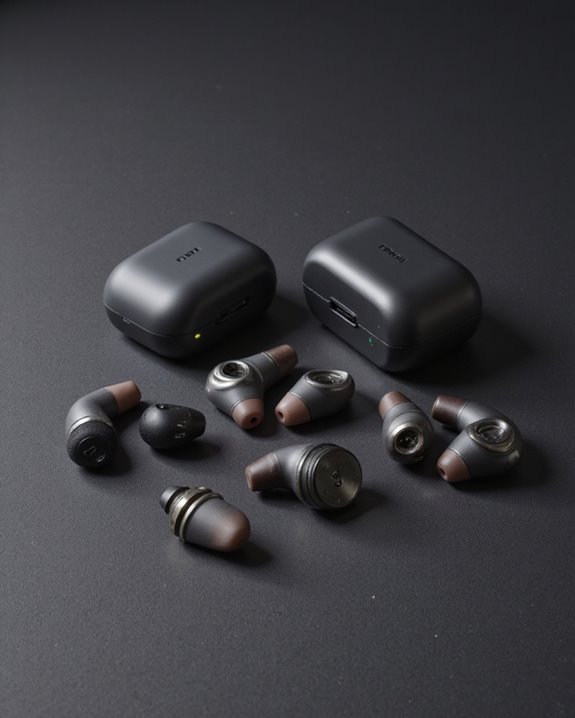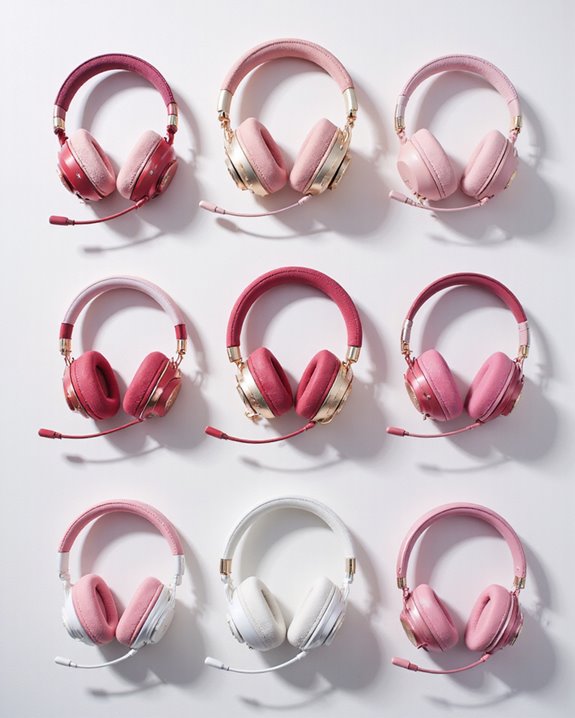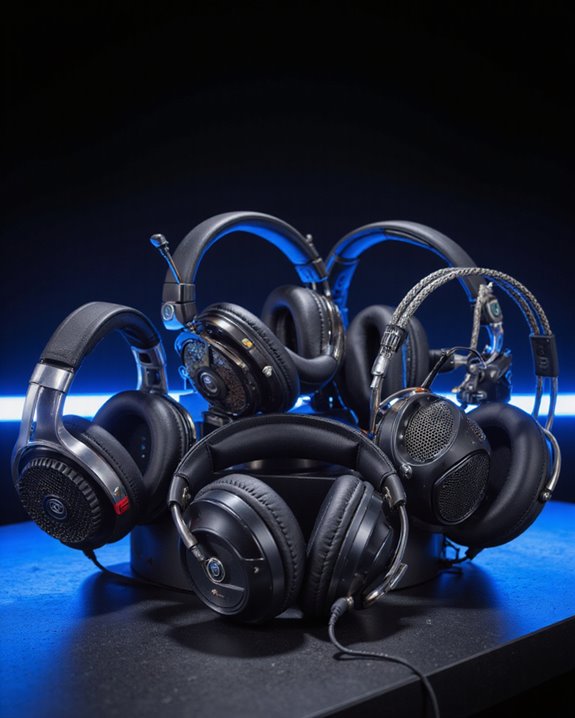Links below are affiliate links. We earn a commission on purchases at no extra cost to you. Although our opinions are based on curated research, we haven't used these products. Articles generated with AI.
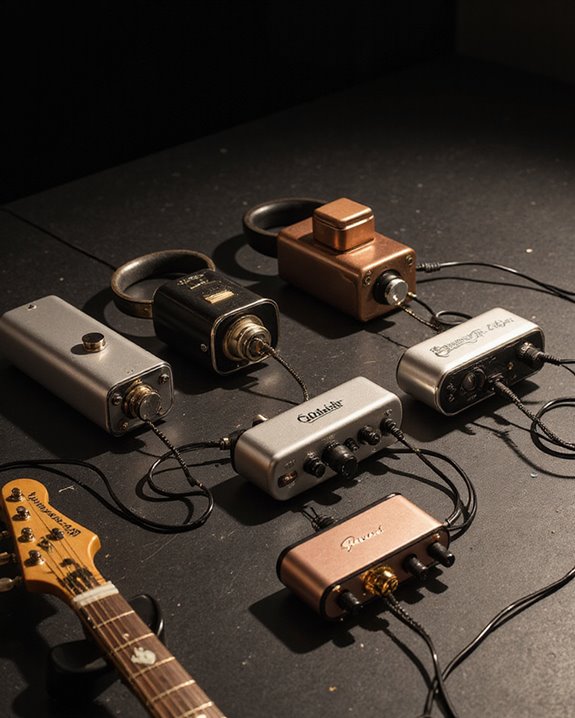
The 5 Best Guitar Headphone Amps of 2025 – Practice in Silent Perfection
The top guitar headphone amps of 2025 deliver professional-grade practice solutions with advanced modeling technology. Fender’s Mustang Micro leads with 13 amp models and Bluetooth streaming, while FLAMMA’s FX20 offers an impressive 52 amp simulations. The LEKATO and SONICAKE models provide USB recording capabilities and built-in drum grooves, perfect for silent practice sessions. Each unit balances portability with premium features, letting you explore extensive tone-shaping options and effects combinations. Discover which specifications align with your specific practice needs.
Key Takeaways
- Fender Mustang Micro leads with 13 amp models and Bluetooth streaming in a compact design ideal for silent practice sessions.
- FLAMMA FX20 offers the most extensive features with 52 amp models and 40 drum grooves for comprehensive practice options.
- LEKATO Guitar Headphone Amplifier provides 14 amp models with 8-hour battery life and USB-C recording capabilities.
- SONICAKE Guitar Headphone Amp Mini delivers classic Tweed tones with 5-hour battery life and built-in reverb effects.
- FLAMMA Guitar Headphone Amp combines 14 amp models with 28 drum grooves in a travel-friendly 10-watt package.
Fender Mustang Micro Headphone Amplifier, with 2-Year Warranty
Sale
Fender Mustang Micro Headphone Amplifier, with 2-Year Warranty
- The Fender Mustang Micro Headphone Amplifier features 5 watts, 6.25Dx6.25Wx2.12H inches
- The Mustang Micro is an all-in-one personal headphone amplifier with onboard DSP, making it a perfect choice at home or on the go
- Small but mighty, it packs 13 amp models for a wide range of clean and dirty tones and 12 effect combinations with parameter modify control
The Fender Mustang Micro Headphone Amplifier is an ideal solution for guitarists who need professional-quality sound without disturbing others. At just 6.25 x 6.25 x 2.12 inches, this 5-watt portable device delivers impressive versatility through its 13 amp models and 12 effect combinations.
You’ll appreciate the onboard DSP technology that lets you shape your tone from clean to dirty, while the parameter modify control gives you precise command over your effects. The built-in Bluetooth streaming and audio/video sync capability make it perfect for playing along with your favorite tracks.
Backed by a 2-year warranty against defects in materials and workmanship, you’re getting Fender’s unmatched quality in a compact, practice-ready package.
Best For: Guitarists seeking a compact, high-quality practice solution for silent playing at home or on the go, especially those who want amp modeling and effects without setting up a full rig.
Pros:
- Extensive variety of amp models and effects combinations for versatile tone options
- Bluetooth connectivity allows for easy music streaming and play-along practice
- Highly portable and compact design with professional-grade sound quality
Cons:
- Limited to 5 watts of power, which may not be sufficient for some applications
- Requires headphones for operation, no built-in speaker option
- May take time to learn and optimize all the available sound settings and effects
FLAMMA Guitar Headphone Amp with Drum Grooves & Effects
Sale
FLAMMA Guitar Headphone Amp Portable with 28 Drum Grooves 14 Built-in Effects 14 Amplifier Models 5...
- 14 Amp Models with Individual Save Function: The FX10 headphone amplifier has 14 calssic amp modules, choose the amp module and adjust the tone color/effects (and the...
- 14 Built-in Effects with Parameter Adjustment: There are 14 effects to choose from, including reverb, delay, and mod, like chorus+hall, phaser+church, flanger+plate,...
- 28 Drum Grooves: Including 7 misical styles: POP, BLUES, PUNK, ROCK, METAL, FUNK and JAZZ. Press DRUM to turn on the drum machine and switch between 3 parameters...
Musicians seeking a versatile portable practice solution will find FLAMMA’s headphone amp packed with professional features. At just 2.08 ounces, this compact device offers 14 amp models and 14 built-in effects, including reverb, delay, chorus, and flanger.
You’ll have access to 28 drum grooves across seven musical styles, from blues to metal, with adjustable volume and speed. The device’s Bluetooth connectivity and USB interface make it compatible with iOS, Android, and laptops for recording and playback.
The FX10 includes five tone color options and delivers 10 watts of output power. You’ll appreciate its battery-powered portability for silent practice sessions and low-noise demo recording.
Best For: Guitarists seeking a lightweight, feature-rich practice amp for silent practice sessions, recording demos, or traveling musicians who need a portable solution with amp modeling and drum tracks.
Pros:
- Extensive variety of amp models and effects with individual save function
- Lightweight and compact design ideal for travel
- Multiple connectivity options including Bluetooth and USB interface for recording
Cons:
- Limited output power at 10 watts
- Plastic construction may affect durability
- Control adjustments require multiple button presses which may be cumbersome
SONICAKE Guitar Headphone Amp Mini (Rechargeable)
SONICAKE Guitar Headphone Amp Mini Guitar Headphone Amplifier US Classic Rechargeable Plug-in Pocket...
- Ideal Carry-On/Bedroom Guitar Effects with Headphone Amplifier for Silent Practicing
- Classic Tweed Amp Clean and Overdrive Tone Tastes On Guitar Headphone Amp
- Built-in Reverb Effects adding additional Sonic Dimensions to the Overall Tone For Guitar Headphone Amp
Practicing guitarists seeking a compact, versatile headphone solution will find SONICAKE’s rechargeable mini amp compelling. At just 4.6 ounces and pocket-sized dimensions of 2.56 x 3.15 x 1.1 inches, this USB-rechargeable unit delivers 5 hours of continuous play time.
You’ll get classic Tweed amp tones ranging from clean to overdrive, with built-in reverb effects that add sonic dimension. The amp works well with both single-coil pickups and humbuckers, producing warm, colorful sounds suitable for blues, jazz, and light rock.
While the thumbwheel controls can be finicky and there’s a slight hum at high volumes, the included headphone splitter and aux input make this an effective practice tool for silent playing sessions.
Best For: Guitarists seeking an ultra-portable, affordable practice solution for quiet bedroom sessions or travel who primarily play blues, jazz, or light rock styles.
Pros:
- Highly portable and lightweight design with 5-hour rechargeable battery life
- Built-in reverb effects and classic Tweed amp tones from clean to overdrive
- Includes headphone splitter and aux input for practicing along with music
Cons:
- Thumbwheel controls can be difficult to adjust precisely
- Slight hum present, especially at higher volume levels
- Limited effects options and not suitable for heavy distortion/metal genres
LEKATO Guitar Headphone Amplifier with Bluetooth & Effects
Guitar Headphone Amp, LEKATO Headphones Amplifier for Electric Guitar and Bass, Features 28 Drum...
- 14 Amp Models & 14 Effects: Craft your signature sound with 14 professional amplifier models and 14 customizable effects. Ideal for electric guitar & bass players seeking...
- 7 Type & 28 Drum Grooves: Stay perfectly in time with 28 drum patterns featuring adjustable speed & volume controls. Fine-tune your sound with 5-level tone brightness...
- Bluetooth Receiver Connectivity: Seamlessly stream music via Bluetooth and jam along with your favorite tracks (compatible with wired headphones/speakers). Note: Receiver...
Modern guitarists seeking a compact yet versatile practice solution will find the LEKATO Guitar Headphone Amplifier an impressive contender. This mini amp delivers 14 amp models and effects through its Tone Architect system, alongside 7 drum types with 28 grooves for jamming sessions.
You’ll appreciate the built-in Bluetooth streaming capability and USB-C connectivity for recording to iOS/Android devices. The rechargeable battery provides 8 hours of practice time through the 10-watt output, while the 3.5mm headphone jack guarantees silent playing.
At $80, it’s pricier than alternatives, and some users report noisy high-gain settings and ergonomic challenges. However, the clear effects and extensive feature set make it a capable practice tool for both electric guitar and bass players.
Best For: Electric guitar and bass players seeking a feature-rich portable practice solution with multiple effects, amp models, and backing drums for silent practice sessions.
Pros:
- Comprehensive suite of 14 amp models and effects plus 28 drum grooves for varied practice
- Multiple connectivity options including Bluetooth streaming and USB-C recording capability
- Long 8-hour battery life with rechargeable battery included
Cons:
- Higher price point ($80) compared to similar alternatives ($40)
- Noisy performance at higher gain settings
- Ergonomic design issues and loose device construction reported by users
FLAMMA FX20 Guitar Headphone Amp with APP and Effects
Sale
FLAMMA FX20 Guitar Headphone Amp with APP 40 Drum Grooves 52 Amp Modes 5 Delay 5 Reverb Effects 14...
- The FX20 electric guitar headphone amplifier features 52 classic Amp models with individual saving functions; 40 Drum Grooves, 14 Modulations, 5 Delay Effects, and 5...
- Specialized mobile FLAMMA App provides more possibilities, a Cloud platform for preset downloading and sharing. Which makes music and sound creation more visual and...
- 40 Drum Grooves in total. Including 7 misical styles: POP, BLUES, PUNK, ROCK, METAL, FUNK and JAZZ. Press DRUM to turn on the drum machine and switch between the grooves...
The compact FLAMMA FX20 headphone amp packs professional-grade features into a pocket-sized device that’s ideal for guitarists seeking versatile practice options without disturbing others. You’ll get 52 amp models, 40 drum grooves across 7 styles, and multiple effects including modulation, delay, and reverb.
With Bluetooth connectivity and USB recording capabilities, you can practice with backing tracks or record directly to apps like GarageBand. The companion app lets you manage presets and download new tones, though you’re limited to 40 total presets that require overwriting to save new ones.
While it offers extensive features for its 2.08-ounce frame, some users report hardware durability concerns with the swivel arm and power switch.
Best For: Practice-focused guitarists seeking a portable, feature-rich headphone amp with diverse amp models and effects for quiet practice sessions and basic recording capabilities.
Pros:
- Extensive library of 52 amp models and multiple effects types
- Compact and lightweight design with Bluetooth connectivity
- Built-in drum grooves across multiple genres with adjustable BPM
Cons:
- Limited to 40 total presets with no additional storage banks
- Some reliability issues with hardware components
- Inadequate user manual and complicated preset management
Factors to Consider When Choosing a Guitar Headphone Amp
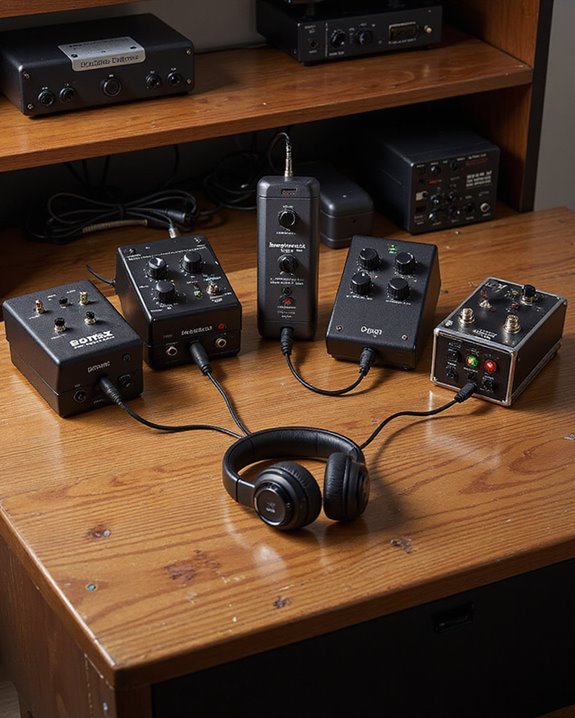
When you’re searching for the perfect guitar headphone amp, you’ll need to weigh several critical factors that affect your playing experience. Your decision should account for sound quality and built-in effects capabilities, battery performance, physical dimensions, and available input/output options that match your setup needs. Consider your budget carefully while examining warranty terms, as these portable amps range from basic models under $50 to professional-grade units exceeding $300.
Sound Quality and Effects
Selecting a guitar headphone amp with the right sound quality and effects capabilities dramatically impacts your overall playing experience. You’ll want to evaluate the number of amp models available, as this determines your tonal range from clean to heavily distorted sounds.
Built-in effects like reverb, delay, and modulation expand your creative possibilities. Look for units that offer adjustable parameters, letting you fine-tune effect intensity and character to match your playing style. The quality of these effects matters just as much as quantity – you’ll need clear, noise-free operation for the best practice sessions.
If you’re interested in improving your timing, consider models with integrated rhythm features. However, don’t let extensive effect options overshadow the importance of core sound quality, as you’ll need pristine audio reproduction for effective practice sessions.
Battery Life and Power
Beyond sound quality considerations, battery life and power output shape how effectively you’ll be able to use your headphone amp for practice. Most units offer between 5 to 8 hours of play time on a single charge, which should cover multiple practice sessions.
Power output ranges from 1 to 20 watts, and you’ll need to balance your volume needs with battery longevity. Higher power settings will drain your battery faster, so it’s worth considering how loud you’ll actually need your amp to be during practice sessions.
Keep in mind that extra features like effects processors, drum machines, and Bluetooth connectivity can reduce battery life by up to 30%. If you’re planning to use these features extensively, you’ll want to look for models with rechargeable lithium-ion batteries that offer extended play times.
Size and Portability
The remarkably compact dimensions of guitar headphone amps make them an ideal choice for musicians who need flexibility in their practice locations. Weighing between 2 and 5 ounces, these devices won’t add noticeable bulk to your gear bag or pocket.
You’ll find most models measure between 1 to 6 inches in various dimensions, making them easy to slip into small spaces. This compact size means you can practice discreetly whether you’re at home, in a hotel room, or traveling between gigs.
The lightweight design, typically under 6 ounces, guarantees you won’t experience fatigue during extended practice sessions. You can easily clip these amps to your belt or keep them in your pocket, allowing for unrestricted movement while you focus on perfecting your technique.
Connectivity and Input Options
Modern guitar headphone amps offer diverse connectivity options that can greatly expand your practice and recording capabilities. You’ll want to prioritize units featuring Bluetooth connectivity, which lets you stream backing tracks wirelessly from your devices during practice sessions.
USB ports are essential if you’re planning to record your playing, as they enable direct connection to computers for audio capture and editing. Look for models with OTG functionality that’ll connect to your smartphone or tablet, allowing instant mobile recording without extra equipment.
When evaluating input options, check for 3.5mm auxiliary inputs that accommodate various audio sources and headphone types. You’ll also need to verify operating system compatibility to guarantee your amp works seamlessly with your preferred recording devices, whether you’re using Windows, Mac, or mobile platforms.
Price and Warranty Coverage
Selecting an ideal guitar headphone amp requires careful consideration of both price points and warranty coverage to maximize your investment. Entry-level models ranging from $40 to $100 offer essential features, while premium options above $80 typically deliver enhanced quality and functionality.
When evaluating warranty coverage, you’ll find most manufacturers provide 1-2 years of protection against manufacturing defects. Higher-priced models often include extended warranty options and superior customer support, making them a practical choice if you’re planning frequent use.
To determine the best value, calculate the cost per year of coverage. While budget-friendly options might seem attractive initially, their shorter warranties could lead to higher long-term expenses if problems develop. You’ll want to balance upfront costs with the peace of mind that comes from thorough warranty protection.
Amp Models and Presets
Versatile amp modeling capabilities form the cornerstone of today’s guitar headphone amps, offering players an extensive palette of sonic options. You’ll find anywhere from 10 to 50+ virtual amp models, replicating everything from pristine clean tones to high-gain distortions.
The ability to save and modify presets is essential for your practice and recording workflow. You can store your favorite combinations of amp models, gain settings, and effects for instant recall when you need them. This feature lets you switch between different sounds without missing a beat.
Your playing style and preferred genres should guide your choice, as the number of available amp models directly affects versatility. Whether you’re practicing blues licks or crafting metal riffs, having access to diverse amp models and customizable presets guarantees you’ll achieve your desired tone.
Frequently Asked Questions
Can I Use Guitar Headphone Amps With an Acoustic-Electric Guitar?
Studies show that over 80% of acoustic-electric guitars are compatible with headphone amps. You can absolutely use a guitar headphone amp with your acoustic-electric guitar, as long as it has a 1/4-inch output jack. The headphone amp will process your guitar’s piezo pickup signals just like it would with an electric guitar’s magnetic pickups. Just make sure to adjust the gain settings appropriately, as acoustic pickups often output stronger signals.
Will Using a Headphone Amp Damage My Guitar’s Input Jack?
No, using a headphone amp won’t damage your guitar’s input jack as long as you’re using it properly. These devices are specifically designed to be compatible with standard 1/4-inch instrument jacks and operate within safe electrical parameters. However, you should always make sure to use gentle pressure when plugging and unplugging, and keep the connection clean and free of debris to maintain best performance.
How Long Do Batteries Typically Last in Non-Rechargeable Guitar Headphone Amps?
You’ll typically get 10-20 hours of continuous play from a standard 9V battery in a guitar headphone amp, though actual duration varies based on usage patterns and volume levels. If you’re using your amp intermittently for practice sessions, a single battery could last several weeks to months. For maximum battery life, remember to unplug your headphones and instrument cable when you’re not playing, as many units don’t have power switches.
Can I Connect Guitar Headphone Amps to External Speakers or Audio Interfaces?
Yes, you can connect many guitar headphone amps to external speakers or audio interfaces, but it depends on the specific model’s output options. Most units feature a standard 1/8″ (3.5mm) or 1/4″ line output jack that lets you send the signal to powered speakers, mixing boards, or audio interfaces. However, you’ll need the appropriate adapter cables to match the connections. Just make sure to check your amp’s manual for compatibility and recommended output settings.
Do Guitar Headphone Amps Work With Active Pickups in Electric Guitars?
Just like a sports car needs premium fuel to perform at its best, your guitar headphone amp needs the right power compatibility with active pickups. While most modern headphone amps work well with active pickups, you’ll want to check the amp’s specifications for impedance matching and gain staging. Many units automatically adjust their input sensitivity, but some budget models might struggle with the hotter output from active pickups, potentially causing unwanted distortion or noise.






